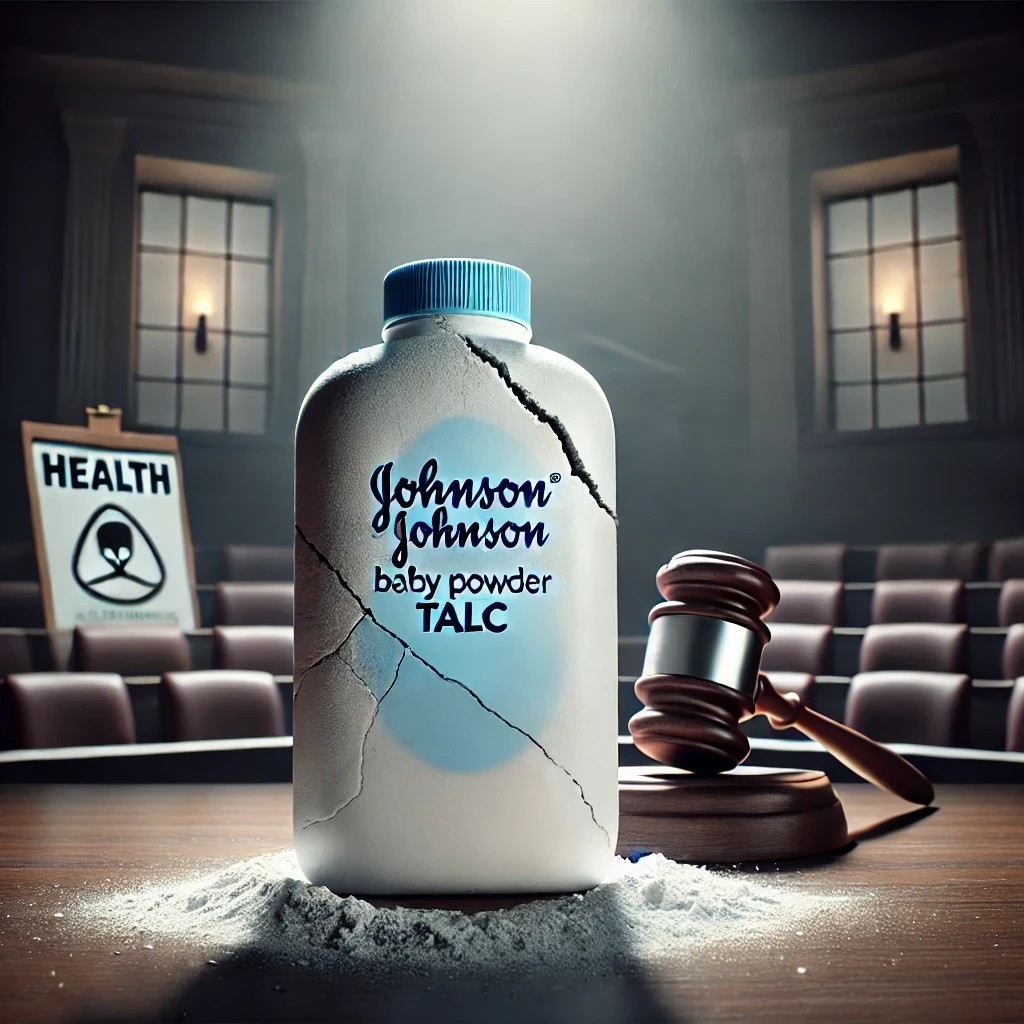For decades, Johnson’s baby powder, a household staple, has faced a growing scandal due to its talc content, allegedly linked to serious health risks. Thousands of talc baby powder lawsuits have been filed against Johnson & Johnson, with plaintiffs claiming that talc-based baby powder products caused health issues, particularly ovarian cancer and mesothelioma. Allegations against the company suggest that asbestos exposure in the company’s talc powder was overlooked or concealed, putting women and other users at risk. This comprehensive look into the issue covers talc litigation, the impact on consumers, and the financial distress the company now faces.
At Mass Tort America, we recognize the serious costs and difficulties many families endure when affected by talcum powder use. With expertise and a team dedicated to guiding clients through the complex talc baby powder lawsuit process, we offer support and insight at every stage. Whether you or someone you know has been impacted by talc products, our concierge team is here to help navigate these legal liabilities.
Understanding The Connection Between Talc And Cancer
Talc, a mineral found near asbestos deposits, has raised red flags in product safety discussions. Research shows small amounts of asbestos can remain in talc unless it undergoes rigorous purification, and inhalation of these fibers has been linked to cancers, particularly ovarian cancer. Human studies show that lifetime use of talcum-based baby powder, such as Johnson’s Baby Powder, on sensitive areas may lead to health risks, including ovarian cancer and other conditions. For patients affected, talc-based products have become more than a mere personal care item—they’ve become a catalyst for talc litigation.
Talc and asbestos exposure were thoroughly studied by entities like the National Institutes of Health, which flagged the potential risks of talc contamination. Even trace amounts of asbestos pose an increased risk, especially with lifetime use of talcum powder. This emerging research prompted calls for more robust safety standards in talc products, though no universal standards currently exist.
Definition And Uses of Talc-Based Baby Powder
Talc-based baby powder is a product made from talc, a naturally occurring mineral composed of hydrated magnesium silicate. Known for its ability to absorb moisture and reduce friction, this powder has been a staple in personal care routines for decades. Parents have long relied on talc-based baby powder to prevent diaper rash and soothe irritated skin, while adults have used it to stay fresh and avoid chafing.
However, recent studies have raised significant concerns about the safety of talc-based baby powder. Research has linked the use of talc powder, particularly in the genital area, to an increased risk of ovarian cancer. These findings have led to a reevaluation of the product’s safety and a surge in talc baby powder lawsuits against manufacturers like Johnson & Johnson.
Introduction Of Johnson’s Baby Powder
Johnson’s Baby Powder, a brand synonymous with baby care, has been a household name for over a century. Introduced in 1894, this talc-based baby powder quickly became popular for its gentle, soothing properties. Marketed as a safe and effective way to prevent diaper rash and skin irritation, Johnson’s Baby Powder earned the trust of parents and caregivers worldwide.
Despite its long-standing reputation, Johnson’s Baby Powder has come under intense scrutiny in recent years. Numerous lawsuits have been filed against Johnson & Johnson, alleging that the company’s talc-based baby powder contains harmful contaminants and poses serious health risks. These legal challenges have cast a shadow over the product’s once-sterling image, prompting a closer examination of its safety.
The Surge Of Talc Lawsuits Against Johnson & Johnson
Over the past decade, talc lawsuits against Johnson & Johnson surged. Plaintiffs allege that J&J’s baby powder contained harmful contaminants. These lawsuits allege that the company failed to disclose the health risks associated with talcum powder, leaving thousands of cases pending in bankruptcy court. Some claim Johnson’s worldwide vice president and other executives knew about asbestos traces in the company’s talc powder since the 1970s but chose not to disclose it.
In response to talc litigation, Johnson & Johnson has faced multiple jury trials, some of which resulted in significant financial distress for the company. The bankruptcy filing of LTL Management, a subsidiary established to handle talc litigation, represents Johnson & Johnson’s strategy to manage its legal liabilities. The Texas Two Step, a controversial bankruptcy system maneuver, allowed Johnson & Johnson to transfer pending cases to LTL Management and shield itself from direct bankruptcy court cases.
The Impact Of Mass Tort Litigation
Mass tort litigation allows patients affected by talcum-based baby powder to join and consolidate their talc baby powder lawsuit cases, amplifying their voices and strengthening their position. Through mass tort actions, plaintiffs share resources to address the financial distress of a prolonged legal process. For women who have used talc-based products, joining this kind of litigation offers a path to seek justice.
Through mass tort cases, courts manage large volumes of similar claims efficiently, helping individuals access product safety resolutions. The collective pressure of talc lawsuits has created a pathway for affected consumers to challenge large corporations. Mass tort litigation against Johnson & Johnson highlights the power of collective action in addressing companies’ failures in product safety.
As talc litigation moves forward, it also exposes weaknesses in the regulatory system. The Senate Judiciary Committee has considered revising bankruptcy laws to prevent corporations from avoiding jury trials through the Texas Two Step or other maneuvers, ensuring that consumers receive fair recourse.
The Science Behind Talc And Health Risks
The mineral talc, often found alongside asbestos, presents potential health risks due to its likelihood of contamination. In clinical oncology, researchers have examined how talc exposure might influence cancer development. When talcum powder particles lodge in the body, they can cause inflammation, which potentially leads to cancerous changes. Human studies suggest that women using talcum-based baby powder in the genital area may face an increased risk of ovarian cancer.
Despite Johnson & Johnson’s assertions that their talcum powder is asbestos-free, various independent studies have detected traces of asbestos in talc products. The company’s claims are further challenged by internal documents that reveal a history of asbestos concerns in its talc-based products. This information has fueled consumer concerns and reinforced the need for better product safety standards.
The National Institutes of Health and other agencies have advocated for enhanced testing methods to ensure talc remains free of contaminants. Researchers are calling for stricter regulations and mandatory disclosures, as asbestos exposure, even in small amounts, poses severe health risks.
The Role Of Internal Documents In Talc Litigation
Internal documents have been pivotal in talc litigation, providing insight into Johnson & Johnson’s knowledge of asbestos exposure risks within their talc-based products. Plaintiffs’ attorneys argue that these documents indicate the company was aware of possible asbestos contamination as early as the 1970s. This has added significant weight to baby powder lawsuits, as plaintiffs claim the company prioritized profits over product safety and consumer health.
These documents have shaped court proceedings, revealing internal communications that allegedly show attempts to downplay or dismiss scientific findings. For talc lawsuits, this kind of evidence strengthens claims that Johnson & Johnson should be held accountable for not alerting the public. Plaintiffs believe the existence of such records points to a failure to disclose crucial information about potential health risks, such as ovarian cancer and mesothelioma.
The use of internal documents highlights the importance of transparency in consumer products, especially those intended for daily use. As these documents continue to surface, they contribute to a growing understanding of corporate responsibility and product safety. The significance of these revelations is evident in the increased scrutiny on Johnson’s baby powder and other talc products.
Johnson & Johnson’s Defense Strategies In Talc Lawsuits
In response to mounting talc baby powder lawsuits, Johnson & Johnson has employed several defense strategies. The company argues that its talcum powder products are safe, free from asbestos, and backed by decades of research. Johnson & Johnson has questioned the reliability of human studies that link talcum-based baby powder to cancer, maintaining that clinical oncology findings are inconclusive. By challenging the scientific validity of these studies, Johnson & Johnson aims to cast doubt on plaintiffs’ allegations.
One key strategy involves questioning the methods used to test for asbestos in talc. The company asserts that certain testing techniques may yield false positives, which could unfairly influence jury trials. This approach is part of Johnson & Johnson’s broader attempt to safeguard its reputation and defend its products in court. However, public skepticism remains high, as many view the company’s defense as a way to sidestep responsibility.
Johnson & Johnson’s commitment to appealing unfavorable verdicts shows its resolve to minimize legal liabilities. Although some appeals have been successful in reducing damages, others have upheld initial rulings. This mixed outcome reflects the complexities of talc litigation and the challenges Johnson & Johnson faces in defending baby powder products amidst widespread public concerns.
Marketing And Targeting Of Johnson’s Baby Powder
Johnson & Johnson has faced criticism for its aggressive marketing and targeting strategies, particularly towards vulnerable populations. The company promoted Johnson’s Baby Powder as a way to stay “fresh and clean,” emphasizing its benefits for preventing body odor. However, this marketing approach has been accused of being misleading and deceptive, as it failed to disclose the potential health risks associated with talc-based baby powder.
Critics argue that Johnson & Johnson’s targeting of African American and overweight women was a form of racial and socioeconomic exploitation. By focusing on these demographics, the company capitalized on their desire for personal hygiene products without adequately warning them of the potential dangers. This has led to widespread condemnation and calls for greater transparency in the marketing of personal care products.
Consumer Advocacy And The Demand For Safer Products
Consumer advocacy groups have been vocal in demanding safer alternatives to talc-based baby powder and greater transparency from the talcum powder industry. Organizations like the National Institutes of Health and other public health groups argue that consumers have a right to know about potential contaminants in their personal care items. These groups push for more stringent product safety regulations to prevent incidents similar to the talc baby powder lawsuit from recurring.
Advocacy efforts have led to public campaigns that educate consumers on talc products and their potential risks. Some groups call for mandatory labeling on talc-based products to inform consumers of possible asbestos exposure and the increased risk of ovarian cancer. These campaigns have gained traction, especially as high-profile talc litigation cases continue to unfold.
As advocacy organizations work to hold corporations accountable, the demand for talc-free and safer baby powder options grows. Companies are now introducing products formulated with alternatives to talcum powder, responding to consumer concerns and shifting toward safer, more transparent practices.
Health Risks Beyond Cancer Associated With Talc Products
While cancer linked to talcum powder has garnered significant attention, there are other health risks associated with prolonged talc use. Some studies indicate that inhalation of talc particles may lead to respiratory issues, particularly in occupational settings where talc dust is prevalent. For workers exposed to high levels of talc, this can result in respiratory conditions similar to pneumoconiosis, a lung disease caused by inhaling mineral dust.
Additionally, talc has been associated with skin irritation and inflammation, particularly for women who use it in sensitive areas. Although these risks are generally less severe than ovarian cancer, they still pose health concerns for regular talcum powder users. Understanding the full spectrum of talc risks enables consumers to make better-informed decisions regarding baby powder and other talc products.
Further research is essential to fully comprehend how talc exposure may affect long-term health beyond cancer risks. For patients and consumers, having access to this information allows for safer choices and this new study underscores the importance of ongoing research into product safety.
The Impact On Black Women
The use of talc-based baby powder has had a particularly severe impact on Black women, who were specifically targeted by Johnson & Johnson’s marketing campaigns. Studies have shown that Black women are more likely to use talc-based baby powder and, consequently, face a higher risk of developing ovarian cancer. This increased risk has been linked to the prolonged use of talc powder in the genital area.
The disproportionate impact on Black women has sparked significant criticism of Johnson & Johnson’s marketing practices. Many argue that the company’s failure to disclose the potential health risks associated with talc-based baby powder has led to preventable suffering and loss. This has fueled demands for accountability and justice for those affected by the product.
The Shift To Cornstarch-Based Alternatives
In response to the talc baby powder lawsuits and health concerns, Johnson & Johnson and other companies have introduced cornstarch-based alternatives to talcum-based baby powder. Cornstarch offers a safer, asbestos-free option, making it appealing for patients who are concerned about the risks associated with talcum j’s baby powder. Cornstarch-based baby powder serves a similar function in personal care routines but without the added risk of asbestos exposure.
Cornstarch-based powders provide comparable benefits in terms of absorbency and softness, while offering consumers peace of mind about potential contaminants. This shift in formulation reflects a broader industry movement toward safer ingredients. By adopting cornstarch and other alternatives, companies respond directly to talc litigation and product safety concerns, aiming to rebuild consumer trust.
As talc lawsuits continue to shed light on product safety issues, companies have realized the need for innovation to meet evolving consumer expectations. The transition to cornstarch-based baby powder is part of the beginning of this response, highlighting the importance of product transparency and the industry’s responsibility to protect public health.
The Impact On Corporate Social Responsibility (CSR)
The talc controversy has significantly affected Johnson & Johnson’s corporate social responsibility (CSR) reputation. CSR initiatives are meant to reflect a company’s commitment to ethical practices and community welfare. However, the baby powder lawsuits and allegations of asbestos exposure have cast a shadow over Johnson & Johnson’s CSR image, prompting consumers to question the company’s dedication to product safety and transparency.
For a brand known for promoting health and wellness, the allegations of contaminated talcum powder present a stark contradiction to its public image. Critics argue that true CSR goes beyond surface-level initiatives and includes ensuring product safety for consumers. The financial distress and negative public perception caused by talc litigation suggest a need for more than just financial restitution; it calls for a realignment of the company’s core values with consumer safety at the forefront.
This situation underscores the importance of authenticity in CSR efforts. Consumers are increasingly scrutinizing corporations, not just for their products but for how their actions align with their stated values. Moving forward, Johnson & Johnson may need to reassess its CSR approach to regain public trust, with a clear focus on product safety and ethical responsibility.
Regulatory Responses And Gaps In Talc Product Oversight
The talc controversy has exposed significant gaps in the regulatory oversight of talc-based baby powder and similar products. In the United States, the Food and Drug Administration (FDA) oversees cosmetics, but its regulatory power is limited compared to pharmaceuticals. The FDA lacks the authority to mandate recalls of contaminated products, relying instead on companies to conduct their own safety assessments and initiate voluntary recalls when necessary. This system has allowed cases pending against Johnson & Johnson to highlight the need for reform in product safety oversight.
The FDA’s limited role in testing for contaminants like asbestos in talc-based products has sparked debates in Congress and among consumer advocacy groups. The Senate Judiciary Committee has reviewed proposals to expand the FDA’s authority, which would enable it to enforce mandatory testing and disclosures for high-risk ingredients, including talc. Proponents argue that these changes are essential to prevent further health crises and protect consumers.
As talc lawsuits continue to bring attention to regulatory shortcomings, there is increasing pressure to establish stricter standards for talcum powder and other talc-based products. For consumers, regulatory reform offers the promise of greater product safety and transparency, addressing the risks that have led to widespread talc litigation.
The Influence Of Media Coverage On The Talc Scandal
Media coverage has played a pivotal role in shaping public perception of the talc baby powder lawsuit against Johnson & Johnson. Investigative reporting has highlighted the health risks associated with talcum-based baby powder, bringing attention to the allegations of asbestos exposure and the impact on consumers’ lives. This extensive coverage has helped amplify consumer concerns, prompting calls for accountability and regulatory reform within the industry.
The media’s focus on Johnson’s baby powder has increased awareness of talc and its potential risks, particularly among women who have used the product for decades. News reports often include testimonials from plaintiffs involved in talc litigation, personalizing the issue and emphasizing the real-world consequences of contaminated products. Social media platforms have further magnified this coverage, with individuals sharing experiences and urging others to avoid talc-based products.
This heightened media attention has pressured Johnson & Johnson to respond more transparently, though public skepticism remains high. For companies in the industry, the talc scandal serves as a reminder of the power of media in influencing consumer behavior and shaping corporate reputations. As talc lawsuits progress, media coverage continues to play a critical role in holding corporations accountable.
Legal Precedents Set By Talc Lawsuits
The talc litigation surrounding Johnson & Johnson has set notable legal precedents, impacting future cases related to product safety and corporate accountability. In several jury trials, courts have awarded substantial damages to plaintiffs who developed cancer linked to talcum powder. These rulings highlight the legal liabilities companies face when they fail to disclose known risks associated with their products, establishing a framework for future cases that involve consumer health risks.
One significant legal precedent involves the use of internal corporate documents to demonstrate asbestos exposure risks in talcum powder products. By presenting evidence that Johnson & Johnson may have been aware of contamination risks, plaintiffs have successfully argued that the company knowingly endangered consumers. This approach has strengthened talc baby powder lawsuits, as it highlights the importance of corporate transparency in cases involving potential harm to public health.
The outcomes of these cases have implications beyond talc-based baby powder, as they set standards for how courts might address similar claims in other industries. As companies observe these developments, many are re-evaluating their own safety protocols to mitigate legal liabilities. For consumers, these precedents underscore the importance of product safety and the right to pursue accountability when health risks are discovered.
Bankruptcy Filing And The Texas Two Step Maneuver
Facing thousands of pending cases in talc litigation, Johnson & Johnson utilized a controversial legal strategy known as the Texas Two Step to manage its legal liabilities. The bankruptcy filing of LTL Management, a subsidiary created by Johnson & Johnson to handle talc lawsuits, shifted cases pending to bankruptcy court. This move allowed the company to seek protection under the bankruptcy system, while limiting its direct involvement in ongoing talc baby powder lawsuits.
The Texas Two Step maneuver, though legal, has sparked considerable debate. Critics argue that it enables corporations to evade full accountability by shifting their liabilities to newly created entities. In this case, talc litigation plaintiffs contend that Johnson & Johnson’s bankruptcy filing prevents them from receiving adequate compensation and forces their claims into a process that may result in reduced payouts.
This strategy has prompted lawmakers to scrutinize bankruptcy laws, with some proposing reforms to prevent companies from using the Texas Two Step to shield themselves from large-scale liabilities. For patients affected by talc-based products, the bankruptcy court proceedings represent another hurdle in their fight for justice, raising questions about fairness and corporate responsibility in the face of health risks.
Impact on Doctors And Healthcare Providers
The controversy surrounding talc-based baby powder has also affected doctors and healthcare providers. Many have faced lawsuits from patients who claim they were not adequately warned about the potential health risks of using talc-based baby powder. Additionally, some healthcare providers have been accused of failing to disclose their financial ties to Johnson & Johnson, raising concerns about conflicts of interest.
This situation has led to calls for greater transparency and accountability within the medical community. As the talc litigation continues, there is a growing demand for healthcare providers to fully inform patients about the risks associated with talc-based products. Ensuring that medical advice is free from corporate influence is crucial for maintaining trust and protecting patient health.
Future Implications For Talc Products And Consumer Safety
The talc baby powder lawsuits against Johnson & Johnson have prompted many companies to rethink their reliance on talc in personal care products. With rising awareness of the potential risks associated with talc-based products, manufacturers are increasingly considering safer alternatives. This shift reflects a broader trend in consumer markets, as individuals demand greater product safety and transparency.
For Johnson & Johnson, the talc litigation serves as a pivotal lesson on the importance of proactive safety measures. The backlash surrounding talcum-based baby powder has highlighted the potential consequences when industries fail to adapt to emerging health concerns. Moving forward, companies may need to invest more in safety research and embrace innovations that prioritize consumer health.
As more consumers become educated about asbestos exposure and its potential health effects, the demand for talc-free options is likely to grow. This shift not only impacts Johnson & Johnson but also sets a precedent for the entire personal care industry, emphasizing the importance of prioritizing consumer well-being over cost-cutting measures.
Why Choose Mass Tort America For Your Case?
At Mass Tort America, we understand the impact that health risks from products like talc-based baby powder can have on individuals and their families. Our legal team is dedicated to helping clients navigate the complexities of talc litigation, providing support every step of the way. With extensive experience in handling talc baby powder lawsuits, we’re committed to fighting for justice and securing compensation for those affected by talcum powder health risks, including ovarian cancer and mesothelioma.
For clients nationwide, our Concierge Team offers comprehensive support, handling everything from filing claims to coordinating legal representation. We know that taking legal action can be overwhelming, but with Mass Tort America, you’re not alone. Contact us today at 800-356-4338 or through our contact form at https://masstortamerica.com/contact/ to learn more about how we can help you. Let us be your advocate in pursuing justice against large corporations that put profits over product safety.



















